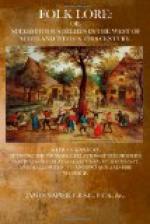To go withershins and to read prayers or the creed backwards were great evils, and pointed to connection with the devil. The author of Olrig Grange, in an early poem, sketches this superstition very graphically:—
“Hech! sirs, but we had grand
fun
Wi’ the meikle black
deil in the chair,
And the muckle Bible upside
doon
A’ ganging withershins
roun and roun,
And backwards saying the prayer
About the warlock’s
grave,
Withershins ganging roun;
And kimmer and carline had
for licht
The fat o’ a bairn they
buried that nicht,
Unchristen’d, beneath
the moon.”
If a tree or plant grew with a twist contrary to the direction of the sun’s movement, that portion was considered to possess certain powers, which are referred to in the following verse of an old song:—
“I’ll gar my ain Tammy
gae doun to the Howe
And cut me a rock of the widdershins
grow,
Of good rantree for to carry
my tow,
And a spindle of the same
for the twining o’t.”
Pennant refers to some other practices in Scotland in his day, that were no doubt survivals of ancient heathen worship. Such as on certain occasions kindling a fire, and the people joining hands and dancing three times round it south-ways, or according to the course of the sun. At baptisms and marriages they walked three times round the church sun-ways. The Highlanders, in going to bathe or drink in a consecrated fountain, approach it by going round the place from east to west on the south side. When the dead are laid in their grave, the grave is approached by going round in the same manner. The bride is conducted to the spouse in presence of the minister round the company in the same direction; indeed, all public matters were done according to certain fixed ideas in relation to the sun, all pointing to a lingering ray of sun worship.
If a fire were slow or dour to kindle, the poker was taken and placed in front of the grate, one end resting on the fender, the other on the front bar of the grate, and this, it was believed, would cause the fire to kindle quickly. This practice is still followed by many, but being compelled now to give an apparently scientific reason for their conduct, they say that it is so placed to produce a draught. But this it does not do. The practice originated in the belief that the slow or dour fire was spell-bound by witchcraft, and the poker was so placed that it would form the shape of a cross with the front bar of the grate, and thus the witch power be destroyed. In early times when the poker was placed in this position, the person who placed it repeated an Ave Marie or Paternoster, but this feature of the ceremony died out, and with it the reason for the practice was forgotten. I have seen it done in private houses, and very frequently in the public rooms of country inns. Indeed, in such public rooms it was the common practice when the servant put on a fire, that after sweeping up the dust she placed the poker in this position, and left the room. Probably she had no idea why she did it, but merely followed the custom.




